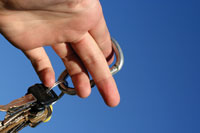 Learning to drive is probably one of the great modern rites of passage for our children. With that coveted license comes independence — and responsibility! — unlike any they have ever known. According to Washington state law, teen student drivers must log a minimum of 50 hours behind the wheel with a parent or other adult driver to be eligible for their license — that’s a half-hour a day for three months.
Learning to drive is probably one of the great modern rites of passage for our children. With that coveted license comes independence — and responsibility! — unlike any they have ever known. According to Washington state law, teen student drivers must log a minimum of 50 hours behind the wheel with a parent or other adult driver to be eligible for their license — that’s a half-hour a day for three months.
For parents, the role of driving instructor can be the last chance they will have to impart their knowledge to their “all- knowing” teen, though some may view the task with dread. Seattle psychologist Russ Hanford says that the dynamics between teens and their parents will have a direct impact on the success of the lessons. Often, the chore falls to the dad. “If there’s a history of tension, or the dad or teen is highly anxious, it’s probably not a good idea,” he says. “But if the relationship is good to begin with, and the two are looking forward to practicing together, it can be a nice bonding experience.”
An important role
Washington state makes it easy for parents to teach their teens to drive with a resource-loaded website (dol.wa.gov/driverslicense/teens.html) outlining all of the requirements the teen needs to fulfill, as well as a downloadable 75-page guide for parents. The state also requires teens to take an official Traffic Safety Education (TSE) course, so dad (or mom!) does not have to be the initial instructor. However, the TSE course only offers about six hours behind the wheel, so the bulk of the teen’s experience will be with a parent in the passenger seat. I
t’s important for dad to take his role as teacher seriously and set a good example when he’s behind the wheel. “The standard I set is high,” says Martin Pinter of Seattle, who has taught his daughter to drive and is in the process of teaching his son. “If I’m not comfortable with the kids’ driving, they’re not going to get their license.” A UPS driver, Pinter spends his day on the road, so he is too aware of the many possible traffic mishaps.
Pinter starts his kids out in the big parking lot at Boeing and brings cones for them to maneuver around. It’s a great place for the teen to get the feel of the car and learn the basics of acceleration, steering, braking and turning. Seattle dad Jay Caldwell recommends initial drives at daybreak when traffic is minimal, though he admits that’s a challenging time of day for teens. He also favors parking lots where student drivers can practice without distractions.
Temperament matters
Caldwell’s two children are now veteran drivers, and he says their personalities definitely played a role in their learning experience. His daughter had enthusiasm tempered with caution. “I also knew she had the klutz gene,” says Caldwell, “so I was a bit wary of her keeping control of the multiple external and internal inputs and responses necessary to drive.” Caldwell first spent about 15 minutes going over the controls and adjusting the seats and mirrors, then discussed appropriate responses to various driving situations. “The mantra ‘When in doubt, stay to the right’ soon crept into her dreams,” Caldwell says. “She was off and driving up one lane of parking spots, turning left, and down the next lane—over and over again, the basics, signaling at each turn, until it was second nature.” After an hour or so of very simple maneuvers, Caldwell let his daughter drive the mile home on city arterials and streets. She did very well. “I think the key to it all was to keep calm and to keep on repeating the basics of driving over and over again,” says Caldwell. “While repetitious and annoying, it seeps into their consciousness and I think helps them in unexpected situations.”
Caldwell’s son was another story. Highly coordinated and overconfident, he was sometimes unwilling to take direction. “The real difficulties crept in only when he was convinced he knew enough that he no longer had to listen,” Caldwell says. “I learned I had to adapt to the personalities of my children. While I went through the same methodology with my son as I had with my daughter, I found I could not comment or criticize his driving. So when he was riding with me, I would comment on what I was doing and why. This was a less threatening approach and seemed to work better. It (mostly) soaked in.”
Pinter made sure both of his kids logged hours in adverse weather conditions; there’s no getting around driving in the rain in the Pacific Northwest. On the next rainy weekend, he’s planning to take his son to a big parking lot to teach him how to handle a skid. He’s also looking forward to a trip up to one of the mountain passes so his son can get a chance to drive in the snow.
Beyond driving
It’s easy for seasoned drivers to forget the basics that a new driver needs to know about vehicle care—everything from pumping gas to changing a tire and putting on chains. “I want the kids to know the basics of car maintenance,” says Pinter. “I see people driving with tires that are half full a lot. They need to recognize the idiot lights.Three months into my daughter’s driving on her own, a [dashboard] light came on. She automatically stopped and called us. It was just a brake light, but it could have been something more serious.”
In the end, if parent and teen work together and put in those hours behind the wheel, the payoff will be an independent teen on the road to adulthood. But even after the state awards that plastic card, parents can and should stay involved. Pinter notes that when his daughter first started driving to work on her own, he plotted her route to avoid tricky traffic situations, and says, “I probably do more than needs to be done, but I want them to be safe.” Spoken like a true dad.
Andrea Leigh Ptak is a freelance writer and graphic designer in Seattle whose 15-year-old daughter is eager to get behind the wheel.
Resources
Washington State Department of Licensing: dol.wa.gov/driverslicense/teens.html
Washington State Parent Guide to Teen Driving (PDF): dol.wa.gov/driverslicense/parentguide.pdf









